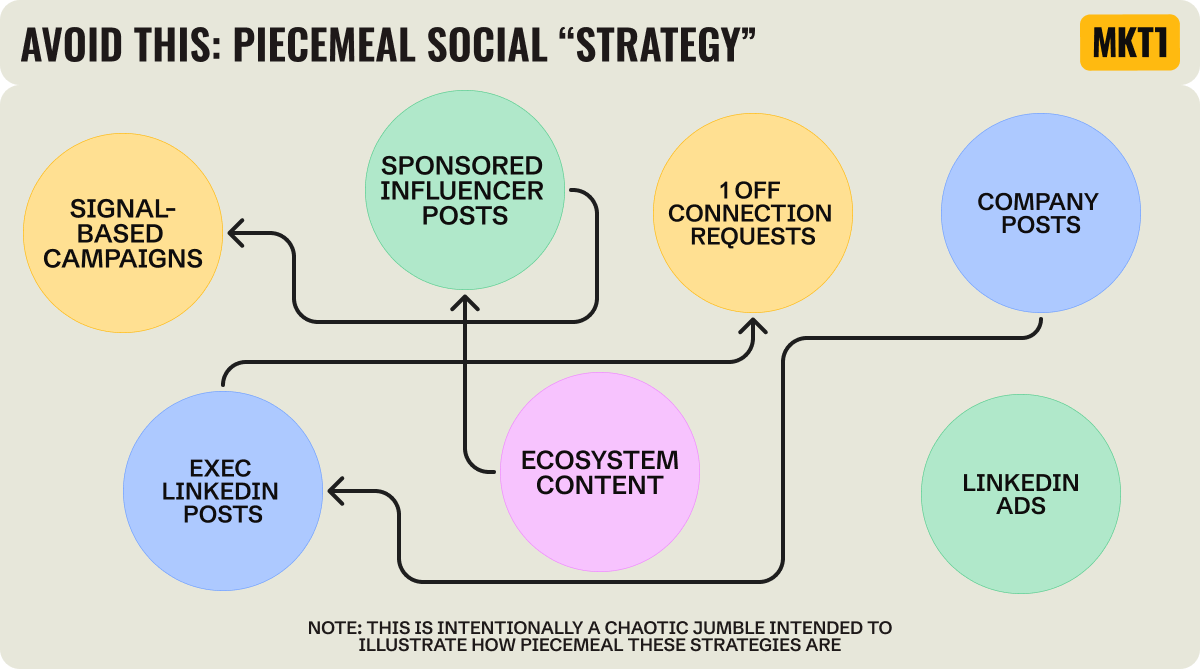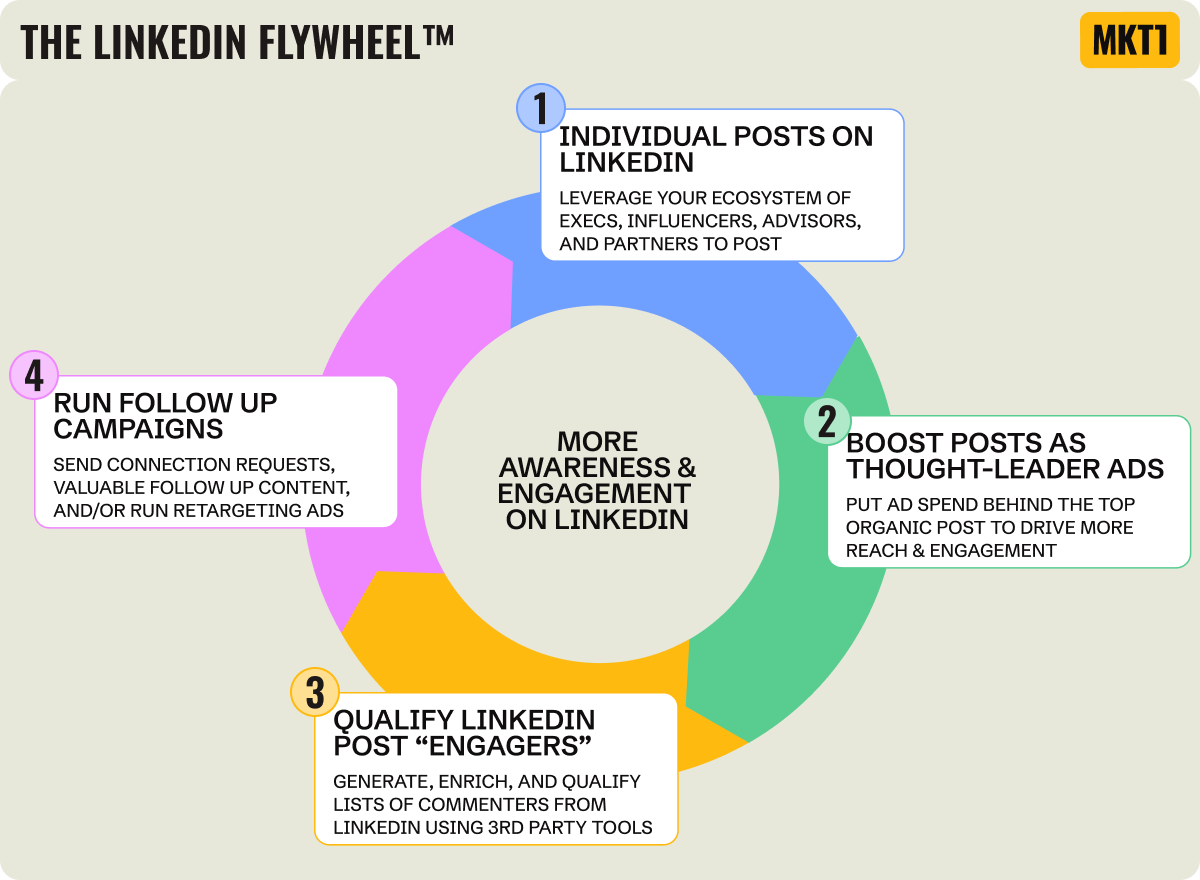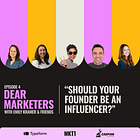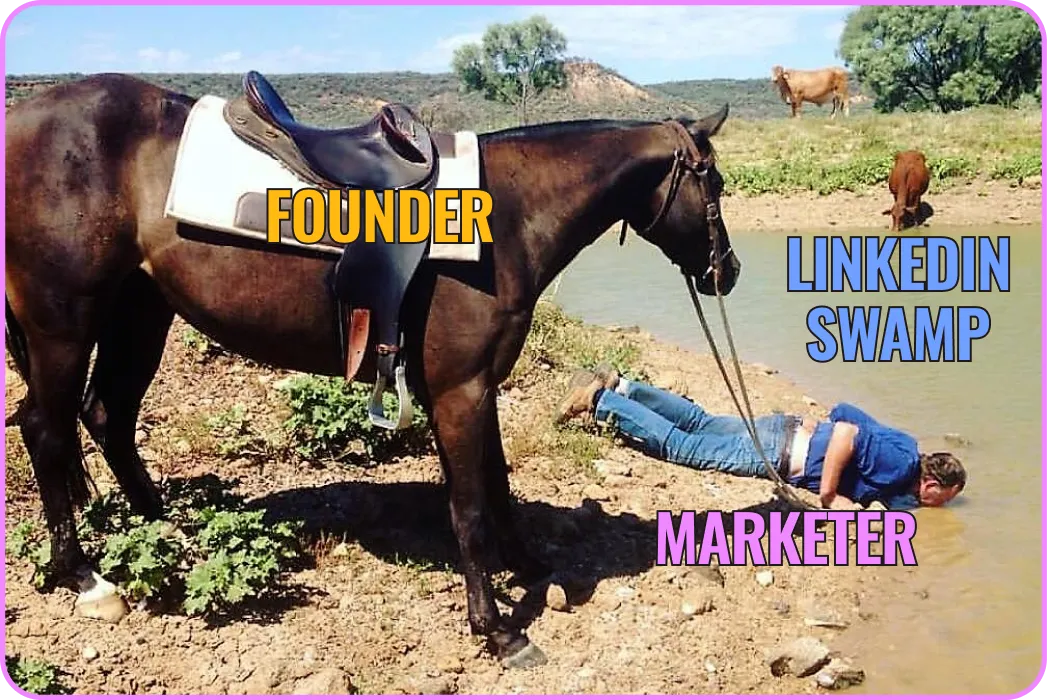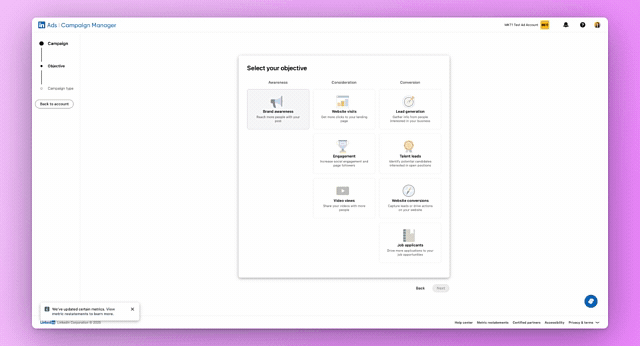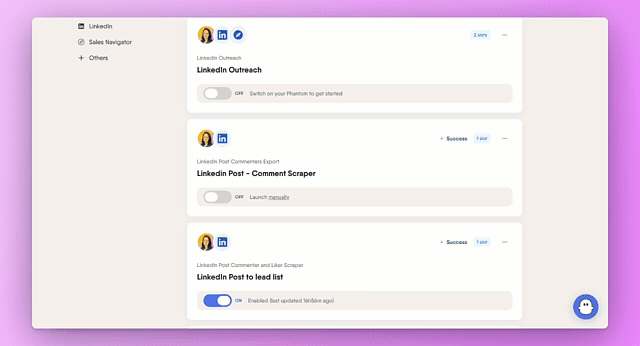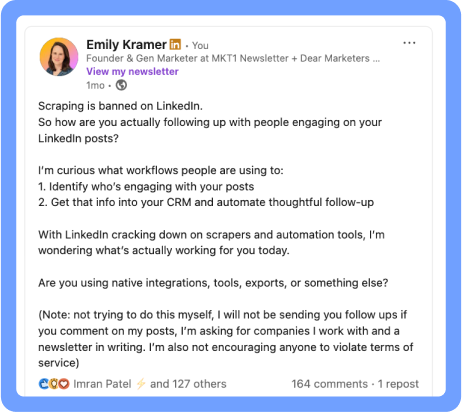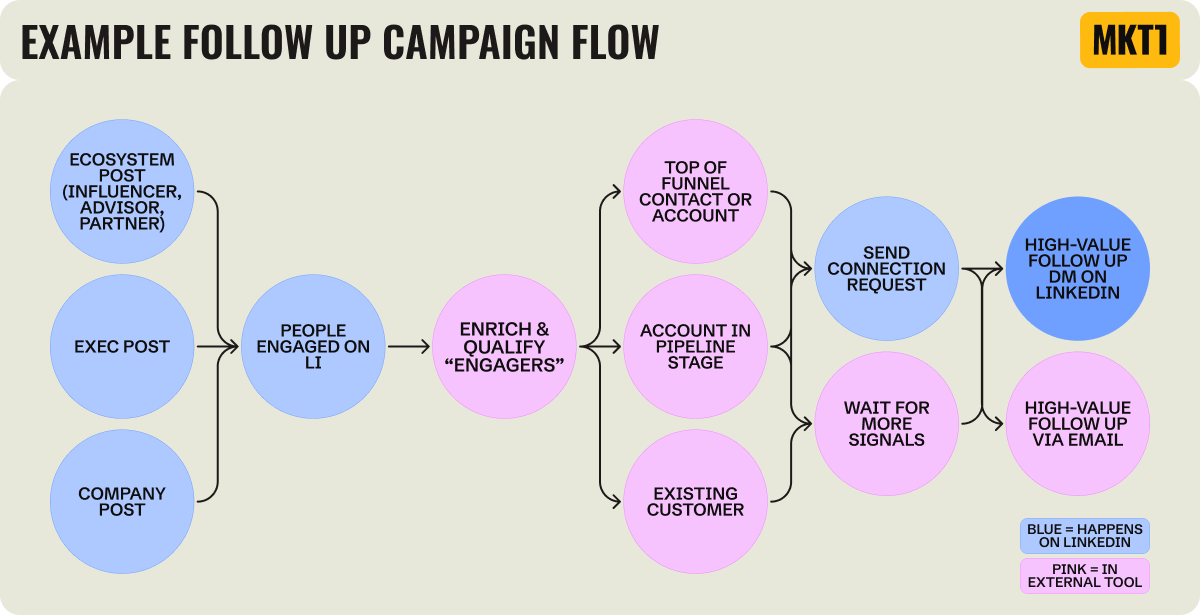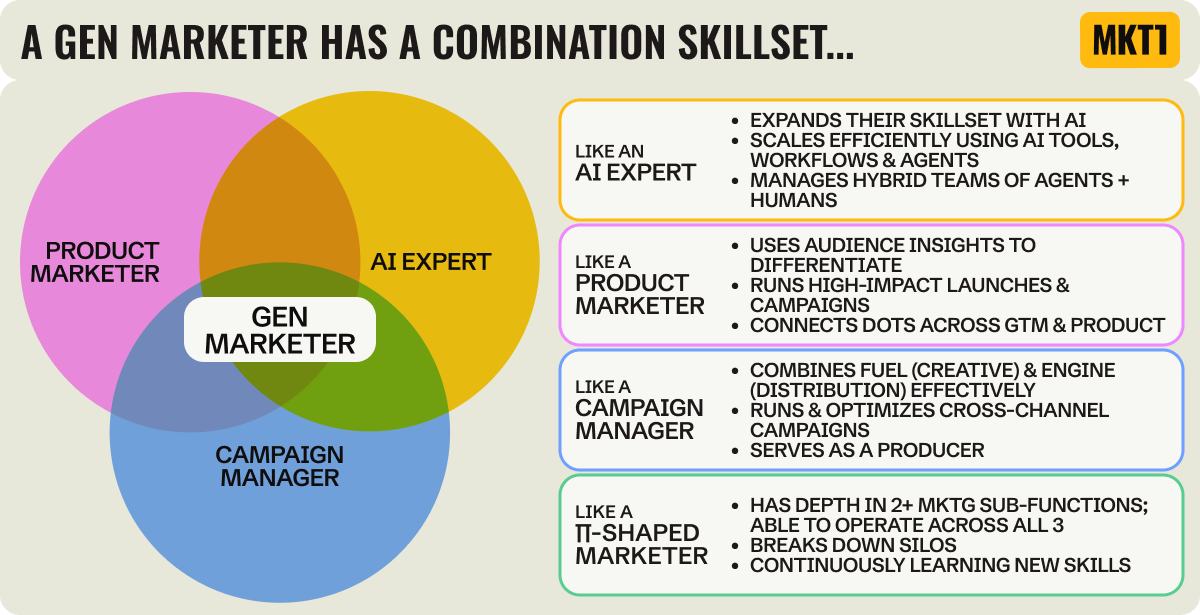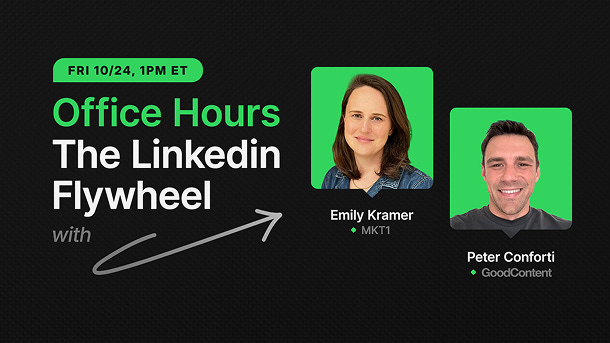Build a LinkedIn Flywheel, not a disconnected social strategy
How to combine your influencer, executive thought leadership, paid social, and signal-based campaign efforts into a compounding growth machine
👋 This is a monthly free edition of MKT1 Newsletter—a deep dive into a B2B startup marketing topic, brought to you by 42 Agency, Attio, and Default.
Upgrade to a paid subscription to get 100+ templates & resources, a vetted contractor & agency list, exclusive discounts on marketing tools, free posts on the MKT1 job board, and full access to the MKT1 archive, including bonus newsletters.
You’re doing LinkedIn wrong. No, this isn’t a rant about the algorithm or a personal manifesto on quitting LinkedIn. LinkedIn is still one of the best places for B2B startups and marketers to spend time right now (that’s why I basically live there).
The problem is your LinkedIn strategy isn’t really a strategy—it’s a collection of disconnected efforts.
You might have the right ingredients: an influencer program, an exec thought leadership calendar, a few ads running through an agency, and occasional follow-up DMs to social commenters. Adding insult to injury, these efforts are usually handled by multiple marketers. But this is not a strategy, it is random acts of marketing, as I love to say.
If you combine these ad hoc efforts, rework the recipe, and streamline ownership, you can build a LinkedIn Flywheel that actually spins out pure gold. Okay, I’ve gotten carried away. But it is not an exaggeration to say that most startups doing any of these individual activities are truly sitting on a LinkedIn goldmine; they just have the wrong tools and workflows to mine it.
The fix isn’t to post more, spend more, or switch agencies. It’s to build a LinkedIn Flywheel™ that makes these pieces work together, helping you avoid wasted effort and allowing your results to compound. There’s no one-size-fits-all approach to LinkedIn, but there is a method to the madness you can adapt for your startup.
In this newsletter:
What is the LinkedIn Flywheel?
Step 1: Executives and influencers post on LinkedIn
Step 2: Boost organic posts with Thought Leader ads
Step 3: Qualify LinkedIn post “engagers”
Step 4: Send follow-up campaigns to LinkedIn “engagers”
Why you need a Gen Marketer to own your LinkedIn Flywheel
Templates & resources (for paid subscribers): Influencer campaign brief, Walkthroughs: How to run Thought Leader ads and extract “leads” on LinkedIn
Recommended products & agencies
We only include sponsors we’d recommend personally to our community. If you are interested in sponsoring our newsletter, email us at sponsorships@mkt1.co.
42 Agency: Let 42 Agency handle the MOPS work your team avoids. From routing logic and fixing scoring, to aligning HubSpot + Salesforce, to setting up new GTM tooling, 42 Agency is ready to help your B2B startup clean up and scale your ops.
🎁 Offer: Mention MKT1 to get 10% off a HubSpot Audit or HubSpot Sprint.
—
Attio is the AI-native CRM. With automatic enrichment, call intelligence, AI agents, customizable record pages, flexible workflows, and detailed reporting, it just works better and doesn’t require months of set-up. We even use it at MKT1.
🎁 Offer: MKT1 subscribers get 15% off your first year.
—
Default: Automate inbound with enrichment, meeting scheduling, AI workflows, and alerts when target accounts browse your company’s website.
Heads up: Default and Attio go together like peanut butter and jelly. Default is the highest converting scheduler for startups using Attio.
🎁 Offer: Mention MKT1 to get 2 months free on any plan for up to 10 seats ($1500+ value).
Part 1: What is the LinkedIn Flywheel™?
The LinkedIn Flywheel combines ecosystem marketing and executive thought leadership, with organic and paid LinkedIn posts, and signal-based campaign efforts into a single program. I’ll break down each piece in detail.
When done in this specific order, you’ll get high-quality “fuel” from people who know your space best to kick-off the process, boost distribution on the best posts, and finally follow up with engagers. This engagement will drive more social followers, both the individuals who posted and your company, and you’ll be able to rinse and repeat.
Before I go any further, I know what some of you might be thinking: SPAM! In my previous LinkedIn post teasing this topic, I heard these concerns about building this flywheel.
So let me just get this out of the way: Don’t spam people. Every LinkedIn “like” shouldn’t trigger a 12-step outbound sequence. The trick is to identify people who may be interested in more content, community, and products your company offers and engage with them in meaningful and valuable ways.
Step 1: Executives and influencers post on LinkedIn
🌀 Overview: To feed the flywheel, you need content that actually performs on LinkedIn, which means thought leadership posts from humans, not your company account. You need to prioritize real voices with real credibility: in-house experts, founders, or people in your ecosystem who already have a following or influence with your audience. Because why start from scratch when you can amplify what’s already working?
🎯 Goals: Get individuals posting in their authentic voices about the ideas, POVs, news, and products that matter most to your company right now.
⚠️ Pitfalls: Spoon-feeding execs or influencers content to post when they have zero interest in the subject matter. And relatedly, prioritizing quantity over quality—posting generic, uninteresting content just to “check the box.” This leads to uninspired, low-engagement content that clutters feeds instead of sparking conversation.
⚙️ Step 1 details: How to get the best-fit people to post on LinkedIn
Start with the right people: The best LinkedIn voices might be your own executives, or they might sit outside your company. Look for ecosystem partners or trusted 3rd-party creators who already have credibility and relationships with your audience.
Note: you can complement individuals’ posts with posts from your company account, but these typically won’t perform as well.
Keep posts aligned to your story: Whether the person posting is internal or external, make sure content ladders up to your high-level narratives and topics that define your company’s story (write content Perceptions™ & Pillars).
Remember: Even though you’ll provide guidance on what to say, make sure posts still sound like they come from the individual and don’t force them to use specific copy!
Mix up the formats: Encourage variety and pick the best format for the content itself—carousels, text-based, reels, polls, and more. The LinkedIn algorithm shifts constantly, so keep cycling through.
Engage in the comments: I can’t overemphasize the value of the poster engaging with commenters. This drives more reach, and drives more comments, which means more engagement “signals”—plus you can learn a lot about your ICP this way.
Adapt your approach: The workflow will differ depending on whether you’re working with internal execs, external advisors or investors (that you aren’t paying) or external creators and influencers (that you are paying), so adjust your process accordingly in the next steps.
How to get execs posting
Find the right execs: Look for people who meet three criteria: (1) they have credible, opinionated POVs, (2) their audience overlaps with your ICP, and (3) they have the time and motivation to engage consistently.
Capture ideas in bulk: Kick off by aligning on themes, perceptions and topics in advance. Then give execs an easy way to share ideas and capture thoughts: use a private Slack channel, voice notes, or monthly recorded convos, etc. You can repurpose these thoughts or recordings into multiple posts.
Batch and plan: Based on the ideas captured, create draft content and send to the exec to approve in batches. 1–2 batches per month should help you maintain a steady 2+ posts per week cadence (which is the minimum cadence necessary to start building a following and driving real engagement on LinkedIn).
Make posting frictionless (but don’t post and ghost): Get the exec’s login (there’s no way around this!), use a scheduler like Assembled, and post at consistent times. Make sure the exec spends 30–60 minutes replying to comments and engaging in their own voice.
I did a whole podcast episode and newsletter on this topic, check it out:
And I will now re-use my favorite self-made meme to remind you that if your founder really doesn’t want to be a thought leader on LinkedIn, you will likely never be able to make them. But good news…if they aren’t the right choice, you can use other execs or leaders and/or look to your ecosystem.
How to run sponsored LinkedIn campaigns with ecosystem partners
Pick the right partners: Look for creators or “LinkedInfluencers” who already have credibility and trust with your target audience. The key is relevance and audience overlap, not just follower count.
Share a brief: Be clear about the campaign background, storylines you want to drive, and any other big initiatives happening at your company. Then let creators express them in their authentic voice. (Yes, we have a template brief to share with creators)
Run campaigns in batches: Treat influencer posts like a coordinated campaign. Cluster posts around a strong theme or launch within a ~2-week window (or 4–6 weeks if each influencer is posting multiple times). This creates momentum and makes your message feel everywhere for your audience.
Keep the content native: The best posts don’t feel like ads. Encourage partners to share their own POV, lessons, or workflows, experiences—content that reads like their usual posts, not a brand press release. Remember: They likely know how to speak to your audience better than you do!
Tools that make it easier: Platforms like Passionfroot and Limelight help you source and manage influencer collaborations, track results, and pay creators—though going direct can also work well. You can also use Clay or other enrichment tools to pull LinkedIn followings for your audience.
➜ Influencer brief template (for paid subscribers): Use this template to run an influencer campaign on LinkedIn. It helps you share the right details, keep messaging aligned, and help influencers stay authentic while speaking to your audience. For paid subscribers.
Step 2: Boost organic posts with Thought Leader ads
🌀 Overview: Once you have high-quality organic posts, the next move is amplification. Instead of coming up with ads in a vacuum, Thought Leader ads let you take the best-performing organic, human content and put paid spend behind it so more of the right people actually see it. Done right, this combines the authenticity of organic posts with the reach and targeting power of paid.
🎯 Goals: Use paid Thought Leader ads to extend the reach of your top 10–20% organic posts from individuals.
⚠️ Pitfalls: Promoting posts that didn’t work organically, using poor targeting, and over-spending before testing—start small, scale what works.
⚙️ Step 2 details: How Thought Leader ads work
Expanded interactive walkthrough for paid subscribers (like the one above but better!) here »
Start with proven organic hits: Wait at least 24 hours after an organic post, then pick your top 10–20% of posts by engagement rate and boost that as a Thought Leader ad.
Get author buy-in early: You can only promote posts from people who approve your request to make that post a Thought Leader ad, so make sure this is in your sponsorship agreement if working with external creators (it’s called paid usage rights). It’s pretty common to include 3 months of paid usage in a deal with your external creators.
Go to LinkedIn Campaign Manager: It’s a bit confusing in there (thanks LinkedIn for the beautiful UI as always!). Here are some big things to note:
There’s no option labeled “Thought Leader ad.” Choose Engagement or Brand Awareness as your campaign objective, and it will let you make this type of ad a few steps later.
After you set a budget and targeting, you can then find the post from the individual you want to promote, select it, and request approval from the author. You might think the ability to select the post should happen earlier in the set-up process…but it doesn’t!
Once the author approves your request to use the post as an ad, go back into Campaign Manager, add the post to your campaign, and launch it.
When setting your budget, start small (around $50–100/day) and scale what works.
Reminder: I’ve got a full walkthrough for you on how to do this for paid subs (a better version of the GIF above!)
Optimize and refresh: Don’t just watch impressions, track engagement quality, comments, and reactions. Promote new high-performing posts, pause anything stale, and use these insights to fuel the next step of your LinkedIn Flywheel.
Pro-tip from Jonathan Bland (Co-founder, Omni Lab): “The big mistake is treating thought leader ads like brand ads. They need a conversational hook, not a headline. Otherwise, they scroll right past.”
Step 3: Qualify LinkedIn “engagers”
🌀 Overview: Your amplification efforts create a goldmine of engagement signals—likes, comments, and profile views. You need to capture and prioritize those signals.
🎯 Goals: Systematically collect and enrich contacts from both organic and paid posts. Organize those signals into info that marketing and sales teams can act on.
⚠️ Pitfalls: Over-scraping or automating can backfire (LinkedIn will notice, plus commenters may be very annoyed). Be thoughtful about data hygiene and privacy consent, and avoid drowning your team in unqualified lists.
⚙️ Step 3 details: How to go from LinkedIn to usable data
Expanded interactive walkthrough for paid subscribers here (like the one above but better!)»
🚨 “Fine print” warning: LinkedIn explicitly prohibits scraping or automated data collection in its Terms of Service. If LinkedIn detects suspicious activity—like automation or scraping—it can temporarily restrict your account or permanently ban it. Tools that offer Chrome Extensions really make LinkedIn mad.
But don’t worry, despite this warning you can still “scrape” comments in a semi-automated way without tipping off the LinkedIn gods:
Get a list of commenters and engagers: There are many tools to do this, from Phantombuster to Assembly to Trigify (remember to follow the terms of service!) These tools provide downloads of all the comments or commenters from a post.
Develop a system for triaging and enriching LinkedIn “leads”: Before you connect with, send an outbound email, run a retargeting campaign, etc. to any of these commenters or likers of your posts, you should determine if they are in your ICP and worth engaging with. Now, of course, you should comment back on LinkedIn to anyone you want—that’s just polite—but I’m talking about before you take further action to move them down the funnel.
Match engagers to target accounts: Ideally, you go beyond an ICP check and determine if these individuals are in your target accounts. This assumes you are using an account-driven GTM foundation (where you’ve loaded target accounts into your CRM and tiered them, more in this newsletter series), which I hope you are!
Track your new and existing connections: You need to understand who is actually accepting the connections, as an accepted connection gives you the ability to message on LinkedIn without using InMail. Add this as a field in your Clay table or attribute in your Attio CRM (or wherever else you’re keeping track of this list).
Need more help? I asked on LinkedIn (where else?!) how people manage this process, read all the responses here.
Step 4: Run follow-up campaigns to LinkedIn “engagers”
🌀 Overview: Once you’ve captured “leads”, the next step is warm follow-up. Instead of cold outreach, you’re reaching out to people who already raised their hand by engaging with your posts. You’ll send a connection request or a message that offers something very valuable—think executive dinner invites, a template relevant to the LinkedIn post, an ask to use their comment to make another LinkedIn post, etc.
🎯 Goals: Set up manual and automated workflows to reach out to the LinkedIn commenter without being spammy to build brand awareness and move your ICP down the funnel.
⚠️ Pitfalls: The biggest risk in this whole process is overusing automation and making both prospects—and LinkedIn—hate your company. Be careful with large-scale automated connection requests or outreach that lack personalization or value. Sometimes, doing a few steps manually is the better move. And don’t rush it—if someone just likes or comments on a post, don’t immediately ask for a meeting. That’s moving too fast. (Perhaps it’s the LinkedIn equivalent of love bombing someone in a relationship!)
⚙️ Step 4 details: How to follow up with LinkedIn engagers in your ICP
Understand your follow-up options: Depending on the original LinkedIn post, the nature of the engagement, ICP fit, and where the account falls in your lifecycle, you should choose different follow-up methods. Here are your options:
Connection request on LinkedIn with or without a message (limited to ~100 per week per person by LinkedIn)
LinkedIn message to existing connections
Outbound email from sales (I’d avoid this as a first step!)
Add engaged as a “signal,” wait for more engagement, then act when even warmer.
Add value in your follow-up message: If you decide to send a message, don’t waste people’s time. Follow up with something high value, preferably directly on LinkedIn. Here are my best suggestions:
Executive dinner invites.
🤯 To really close the flywheel loop: If the original post was from a partner or expert, host a dinner with that same partner and invite them.
A template or webinar invite relevant to the LinkedIn post.
An ask to continue the conversation, but only if you genuinely plan to use the convo (e.g., to create content you’ll credit them in, record a podcast, or feature their perspective in another LinkedIn post).
Run retargeting ads on LinkedIn: In addition to the options above, retargeting ads are a great way to amp up this flywheel even more if you have the budget.
If you’re running thought leadership ads, you can build retargeting audiences directly from those ad engagements.
If you want to run retargeting ads to engagers on organic posts upload the lead list you made in the steps above as a “Matched Audience” in LinkedIn.
You can also expand audiences and unlock better match rates with tools like Primer, who also happens to be a MKT1-partner.
Track all of this activity using campaign objects in your CRM (we recommend Attio!), so you can tie revenue back to the overall flywheel.
Here are some of your thoughts on this process from LinkedIn commenters:
“Connection requests that say ‘Hey, thanks for liking my post, would love to connect” have the highest connection rate. It is outstanding at 60 to 80%.” - Peter Conforti (Founder, Good Content)
➜ I’m co-hosting office hours with him later this week, RSVP here!
“A startup I advise has seen the most success through manual, highly targeted outreach. It takes time and consistency but it’s far more effective than blasting generic messages to a broad audience. Because they’re going after a very niche audience, their approach has been to engage with people who interact with their posts, add them as 1st-degree connections, and then send thoughtful outbound messages.” - Yi Lin Pei
And on what to avoid: “The amount of spam I get from liking or commenting on posts is out of control. You’re killing engagement this way—people will stop interacting, and we’ll just have one-way shouts into the void.”- Matt Pieper
🌀 The result: After all these steps happen, overall brand awareness on LinkedIn goes up, so future posts do even better, and the wheel spins even faster.
Part 2: So who should own this?
(hint: Gen Marketer needed)
Some might argue the hardest part of implementing the “LinkedIn Flywheel” is building out the daisy chain of tools or working around LinkedIn’s strict policies. Others might argue it’s crafting the right message for each person who engages with your posts, without sounding spammy.
But I’d argue the real problem is simpler: Marketing teams aren’t structured for this kind of workflow (yet).
Each step of the LinkedIn Flywheel is siloed to different specialist roles, and the bigger the team, the worse this is.
Organic LinkedIn posting (from the company or execs): Typically handled by a social media manager or content team.
Sponsored thought leadership posts with ecosystem partners: Handled differently across companies, could be an influencer marketer, partner marketer, demand gen lead, and/or an agency.
Paid campaigns: Run by performance or paid marketers, often by someone in-house, plus an agency.
Tracking engagement and signals: Often owned by RevOps, which may or may not include a dedicated marketing ops person.
Follow-up campaigns: Depending on the campaign, owned by a mix of SDRs, AEs, growth marketers, and lifecycle marketers.
What a mess! 10 different people (plus agencies) can end up owning pieces of this puzzle. The result? Random acts of marketing instead of a coordinated system that compounds.
Solution: A Gen Marketer should own the LinkedIn Flywheel
A Gen Marketer should own this flow, working with specialists and agencies as needed. To recap, a few weeks back I introduced the role of a Gen Marketer, and haven’t stopped talking about it since. A Gen Marketer is a generalist, who is a (gen) AI expert, and ready to handle the generational shift in how we do marketing.
A Gen Marketer is a perfect fit to own the LinkedIn Flywheel because their breadth, depth, and AI skills mean they understand how to:
Build AI-powered workflows and dashboards
Get the right fuel from execs and influencers
Choose the right follow-up channels for each persona
Produce creative assets
Measure the ROI of the entire flywheel—not each disconnected piece
Should you hire a Gen Marketer just to own the LinkedIn Flywheel?
Probably not right away. Start by making this a core workstream of a generalist on your team. As your mix of ecosystem marketing, exec thought leadership, social strategy, and signal-based campaigns scales, this can easily become the full-time focus of a Gen Marketer.
You can also think about this in reverse. If you have a social or partner marketer today, they can expand their skillset to become a Gen Marketer by taking on ownership of all of the LinkedIn Flywheel workflows.
What does this mean for “Social” agencies?
This entire workflow also highlights what’s broken about social agencies. Many agencies operate in silos and only handle pieces of this puzzle. We need agencies that understand this flywheel and help you with the whole thing. If you’re building an agency to help with LinkedIn, you should consider owning or helping with all pieces of the flywheel to remain relevant.
Takeaways & join a live convo on this newsletter!
Most LinkedIn programs underperform because they’re fragmented—posts, ads, and outreach all running separately with no shared strategy. The LinkedIn Flywheel flips that. It connects every piece, so your efforts actually build on each other.
Each step fuels the next: great posts power better ads, ads create engagement signals, signals drive smarter follow-up, and that follow-up sparks even more engagement. The loop keeps turning, and results start to compound.
This is how you move from random acts of marketing to a system that scales. The magic isn’t in doing more on LinkedIn—it’s in making everything you’re already doing work together.
Newsletter Office Hours, co-hosted by GoodContent & MKT1: Friday 10/24
Peter Conforti runs Good Content, an agency that makes video, podcasts, and LinkedIn content for execs. He is a former Dear Marketers Podcast guest and contributed to this newsletter in a big way. So when he asked me to join the first-ever Behind Good Content “Office Hours” session, I said “Of course.”
In this interactive session, Peter and I will talk through the LinkedIn Flywheel in even more detail, explore how B2B brands can bring it to life, debate the right type of role to “own” this motion, discuss if and when to seek external partners, and answer your most pressing Qs about LinkedIn.
More templates and resources:
For paid subscribers only - links directly to these assets in Docs & Arcade available below the paywall.
LinkedIn sponsored post campaign brief for creators/influencers
Complete walkthrough: How to create Thought Leader ads on LinkedIn
Complete walkthrough: How to “scrape” LinkedIn comments and leads
Perceptions™ exercise for aligning your story
Reminder: We have a new and improved template library for paid subscribers. Just enter the same email address you use to subscribe to this newsletter on our library page and you’ll be browsing away…
More from MKT1
🙏 Thanks again to our sponsors: 42 Agency, a paid media and MOPS agency; Attio, the AI-native CRM, and Default for automating inbound workflows.
📖 More LinkedIn Flywheel-related reading:
GTM Strategist Newsletter: How Maja Voja builds LinkedIn Agents in n8n
My original LinkedIn post about this idea, with lots of great comments
My LinkedIn post about how to “scrape” on LinkedIn w/o violating their rules
🧰 Revamped, upgraded template & resource library: We have 100+ templates and resources available to paid subscribers in our brand-new template library.
🛠️ MKT1 GTM tools library: An organized, sortable list of recommended products on MKT1.co.
💰 Discounts list: Active discounts on products we recommend for paid subscribers only.
We also just launched our MKT1 Perk Stack in Beta to Annual Paid Subscribers only (more to come on this deep discount list program soon!)
Full disclosure, we are also part of the affiliate programs for: Clay | Assembly | PhantomBuster | Relay | Make | Retool | Lovable | Gamma | Replit | n8n
🧑🚀 Job board: Jobs from the MKT1 community (free to post as a paid subscriber)
🍽️ MKT1 Supper Club: We’re trying something new: monthly dinners IRL. Small groups with smart people, good food, and conversations on topics that actually matter in your role—made possible by some of my favorite GTM tools. Join the list. Next dinner is in early November in SF!
➡️ Next From MKT1
📰 Next newsletter: Tools to help you with annual planning (I think!)
📹 New video series: Coming next newsletter!
🗓️ Event: Office Hours with Peter Conforti on this newsletter this Friday



